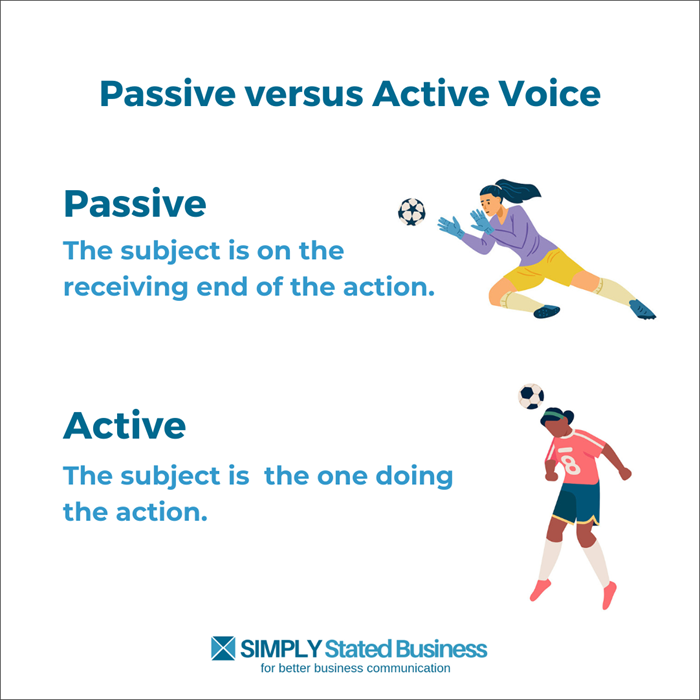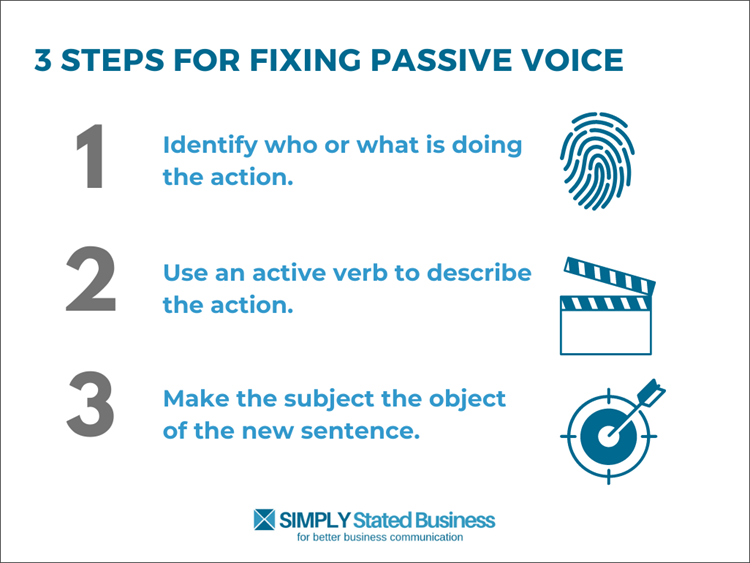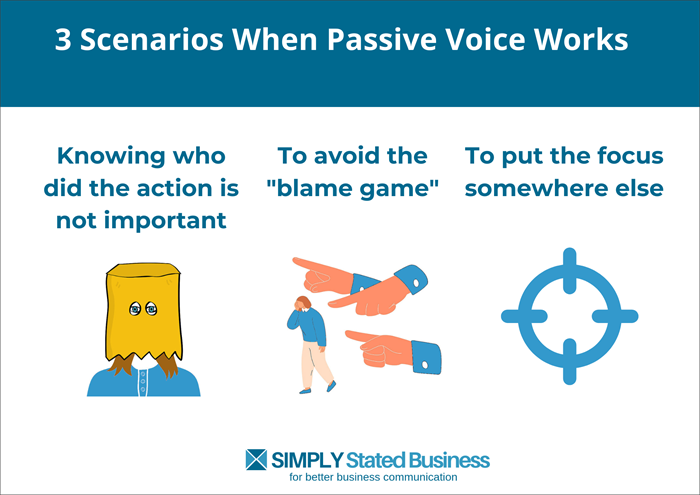
Does a bit of passive voice feel like a welcome change from our volatile world? If we could stop shouting long enough to listen, maybe we could learn something.
But too much passive voice in business writing dilutes your message. You’ll never get heard that way. Maybe a kick in the booty will help.
The following tackles passive voice in 3 steps.
- Identifying passive voice
- Fixing passive voice (when it’s too much)
- Learning how (and when) to make passive voice work
1. Identifying Passive Voice
The mere mention of passive voice has me flashing back to grammar school days in a gush of sentence structure exercises. Your flashback may be an editor who returns your carefully crafted words with a sea of red slashes.
But what the heck does it mean? The voice is the connection between the subject and the object in your sentence. That voice connection is either active or passive.

To Identify passive voice, look at sentence structure.
- Passive – the subject of the sentence is on the receiving end of the action.
- Active – the subject is the one doing the action.
Visualizing a passive example may help. And it may help add zing to your business writing.
Example: The dog was hit.
- In this example, the dog is on the receiving end.
- But was the dog hit by a car?
- Or did its owner hit the dog?
The way the writer structured the sentence, the reader does not know who or what did the hitting. In this example, the writer turned the object (the dog) into the subject.
Active Voice Alternative
Example: The boy hit the dog lets everyone know that the boy hit the dog – not a car or someone else.
- The boy is the subject.
- The dog is the object.
Why structure matters
Better business writing is simple and clear. Passive sentences choke the life out of business writing. Readers hit the snooze alarm and lose your message.
Passive sentences are also habit-forming.
Tips for Recognizing Passive Voice
Clues exist for spotting passive sentences – even without the help of Microsoft Word Editor, Grammarly, or whatever other tool you use.
1. The sentence uses a form of be (is, are, was, will be, has been)
2. Typically, a verb or participle follows the above words (in our example – was hit).
3. And the sentence uses a past tense.
The above tips in Passive Voice: The example has been completed. Easy to spot as 1, 2, 3,
2. Fixing Passive Voice
Once you identify passive voice in your business writing, decide if adjusting the sentence strengthens your writing. Next, try the fix illustrated below.

Using our dog example, apply the following fix.
- Identify who is doing the action – the boy (not the dog).
- Use an active verb to describe the action – hit (instead of was hit).
- Make the subject the object – Instead of: The dog was hit, Use: The boy hit the dog.
3. Learning When Passive Works
The English language does not exist without exceptions. There are times when a passive voice works. The following shares a few examples.

Knowing who did the action is not important.
- You may not know who “did it.”
- Even if you do know, it doesn’t matter.
- Or who did it is obvious (DUH).
Example: The mail was delivered yesterday. Using the active voice – The mail carrier delivered the mail yesterday – adds nothing meaningful.
To avoid the “blame game”
Here’s a concept I wish others would consider more. Use passive voice when you don’t want to blame the person who did the action.
Imagine a world in which blaming others was not a national sport.
Example: Instead of: Joshua miscalculated the total (active voice); Try: The total was miscalculated (passive voice).
Focusing somewhere else
We tend to focus on what comes first. But you may want the reader’s focus on a different part of the sentence. A passive voice can work in that scenario. Check out the following example.
Example: Apple created the iPad.
Now, I am sure Apple executives love the focus on their company. However, if you are writing a product review or relating the history of Apple products, it makes sense to put the focus on the iPad instead of Apple.
Passive Voice example: The iPad was created by Apple.
Avoiding Passive Paranoia
Adjusting business writing to increase your use of active voice produces better business communication. However, avoid falling prey to passive paranoia.
Using a pinch of the passive voice, while seasoning your business writing with power words, produces savory results. Bonus: Download a free list of power words by clicking on the prior link.
Are you ready to kick some passive voice booty? Share your thoughts in Comments about using passive voice in your business writing.
Credit: Bigstock Photo
Credit: Canva
=====================
Helping you keep your business communication simple, clear & uniquely yours.
=====================
Note: This post originally posted on September 1, 2010. This August 13, 2023 version updates it.

You know, when I first started blogging, that English teacher’s voice (and my own mother’s voice) nagged at my writing style. I have learned to let some of that go but I still like good English! Thanks for the tips 🙂
Hi Martha:
Thanks for stopping by. Blogging is definitely a more relaxed style of writing, and you’re right, there is a danger in developing passive paranoia. Like most things in life, it’s all about balance.
Even in blogging, polishing up the writing, let’s the message shine through.
Thanks for sharing your thoughts.